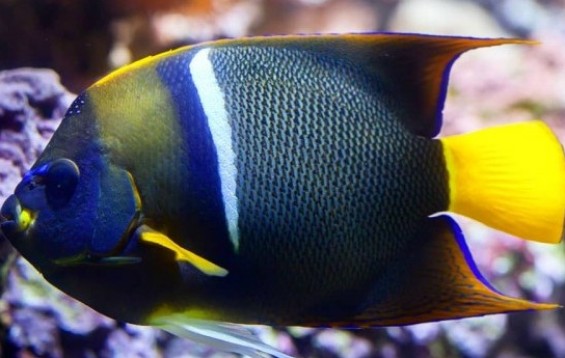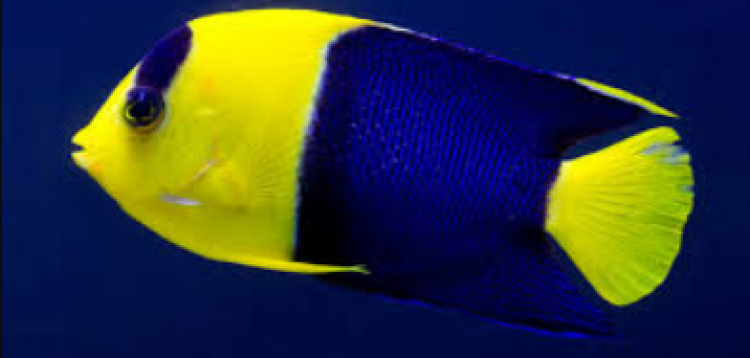- Name:
Passer Angelfish
(View AKA's) - Family: Pomacanthidae
- Species: Angel Large
- Scientific Name: Holacanthus passer


General info about Passer Angelfish
The Passer Angelfish the adult is predominately dark blue with a white vertical stripe extending down from the dorsal fin about two-thirds of the way to the pelvic fin. The dorsal fin is rimmed in yellow. The caudal and pectoral fins are also yellow, while the ventral fins are yellow on a female and white on the male. The juvenile is orange with one white and multiple blue stripes. The Passer Angelfish can grow to over a foot in length so it requires a large aquarium. It is a hardy fish but can become aggressive, so it should be kept with other semi-aggressive tank mates. It grazes on live rock and will nip at stony and soft corals (sessile invertebrates) and clam mantles, so it is not a good candidate for a reef aquarium. The Small Juvenile will contain the Juvenile colorations, the Small-Medium will be color shifting to a young adult, while the Medium will be a sub-adult, and the Large will be in Adult coloration.
Passer Angelfish Diet & Nutrition
The Passer angelfish is an omnivore feeding mainly on filamentous algae and external parasites from other fish in their juvenile stage and as adults may feed on invertebrate eggs, cnidarians, zooplanktons and parasites but mostly on sponges and algae.
In the tank, it is best to provide plenty of rock work for the Passer angelfish to graze on especially for the juveniles that feed mostly on algae. Adults may be fed with a varied diet containing sponge material and Spirulina. They also love Nori, fresh broccoli, caulerpa and a very small amount of meaty fare such as brine and mysis shrimp.
Determining Sex of Passer Angelfish
Male Passer angelfish are usually larger and have white pelvic fins while the females are smaller and have yellow pelvic fins.
Breeding & Spawning Passer Angelfish
Passer angelfish has not yet been bred in captivity. However, reproduction for this species usually occur in the summer from April to November, with peak spawning in October to November. Mating behavior is usually observed at dusk when several males, with the dominant male at the center and smaller males at the edges, gather at the sandy bottom near the reef. When the female arrive, each male will swim toward and above the female to flutter their bodies in short jittery motions. When ready to spawn the female rises towards the male, and the male will move below her belly and nuzzle it with his nose. The pair will both quiver and swim in spirals toward the surface of the water to simultaneously release their gametes. This spawning event lasts for about 30 minutes.
Common Diseases with Passer Angelfish
The Passer Angelfish are fairly hardy once they are established in captivity but if reef conditions were not met they will most likely be affected with the common White Spot disease, Marine Velvet, and the viral infection Lymphocystosis. These angels may also contract a condition called nutritional blindness which is caused by inappropriate levels of meaty food. External parasites are also a threat to the Passer angelfish.
Passer Angelfish Origin
Holocanthus passer are widely distributed in the Eastern Pacific which ranges from the Gulf of California to Peru including the Galapagos Island.
Caution with Passer Angelfish
Passer angelfish are very aggressive, they should be placed in tanks with other active fishes as they are known to attack passive fishes like anthias, batfish, tilefish and butterflyfish, nor with slow moving or stationary fish like frogfishes and scorpionfishes. They are known to nip on a Lionfish's fins and eyes of sharks mistaking them for coral polyps. They are also known to nip on sessile invertebrates stony corals, clams, and most soft corals.
Acclimating Passer Angelfish
When adding 2 or more Passer angelfish in the tank it is best to place them in tanks of atleast 180 gallons adding the smaller fish first and put up a barrier so the larger cannot harm the smaller angelfish, and observe their behavior. The tanks should have plenty of mature rocks with naturally growing algae to supplement diet. Water quality must be kept high and at a pH level of 8.
Original Detail
| Name | Species | Family | Scientific Name | More Detail | Added by |
|---|---|---|---|---|---|
| Passer Angelfish | Angel Large | Pomacanthidae | Holacanthus passer | The Passer Angelfish the adult is predominately dark blue with a white vertical stripe extending down from the dorsal fin about two-thirds of the way to the pelvic fin. The dorsal fin is rimmed in yellow. The caudal and pectoral fins are also yellow, while the ventral fins are yellow on a female and white on the male. The juvenile is orange with one white and multiple blue stripes. The Passer Angelfish can grow to over a foot in length so it requires a large aquarium. It is a hardy fish but can become aggressive, so it should be kept with other semi-aggressive tank mates. It grazes on live rock and will nip at stony and soft corals (sessile invertebrates) and clam mantles, so it is not a good candidate for a reef aquarium. The Small Juvenile will contain the Juvenile colorations, the Small-Medium will be color shifting to a young adult, while the Medium will be a sub-adult, and the Large will be in Adult coloration. |
PalaciosAn |
Changed by users
| Submitted Date | Submitted By | Status | Action |
|---|



